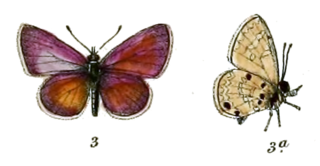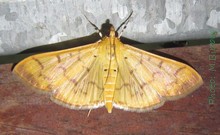
The common blue butterfly or European common blue is a butterfly in the family Lycaenidae and subfamily Polyommatinae. The butterfly is found throughout the Palearctic and has been introduced to North America. Butterflies in the Polyommatinae are collectively called blues, from the coloring of the wings. Common blue males usually have wings that are blue above with a black-brown border and a white fringe. The females are usually brown above with a blue dusting and orange spots.

Azanus ubaldus, the bright babul blue, desert babul blue, or velvet-spotted blue, is a small butterfly found in India, the Middle East and Africa that belongs to the lycaenids or blues family.

Azanus uranus, the dull babul blue or Indian babul blue, is a small butterfly found in India that belongs to the lycaenids or blues family. It was first described by Arthur Gardiner Butler in 1886.
Azanus urios, the Siam babul blue, is a small butterfly found in India and Thailand that belongs to the lycaenids or blues family.

Azanus jesous, the African babul blue or topaz-spotted blue, is a small butterfly found in Africa, Egypt, Syria, India, Sri Lanka and Myanmar that belongs to the lycaenids or blues family.

Azanus, commonly called babul blues, is a genus of butterflies found in Africa and southwestern Asia.

Satyrium spini, the blue spot hairstreak, is a butterfly in the family Lycaenidae.

Azanus natalensis, the Natal babul blue or Natal spotted blue, is a butterfly of the family Lycaenidae. It is found in the Afrotropical realm.

Azanus moriqua, the black-bordered babul blue or thorn-tree blue, is a butterfly of the family Lycaenidae. It is found in the Afrotropical realm.
Azanus sitalces, the large Madagascar babul blue, is a butterfly in the family Lycaenidae. It is found on Madagascar and the Comoros. The habitat consists of forests.

Azanus soalalicus, the small Madagascar babul blue, is a butterfly in the family Lycaenidae. It is found on Madagascar. The habitat consists of forests.

Azanus isis, the white-banded babul blue, is a butterfly in the family Lycaenidae which is native to the tropics and subtropics of sub-Saharan Africa.

Empisini Nature Reserve was established in 1973 and is situated in Umkomaas, KwaZulu-Natal, South Africa. The reserve is approximately 60 ha in extent and is owned by the borough of uMkhomanzi which has been incorporated into the eThekwini municipality. Empisini is managed jointly by eThekwini and the Umkomaas centre of the Wildlife and Environment Society of South Africa. Empisini takes its name from a perennial stream which flows through it, and means "Place of the Hyena" in isiZulu. The reserve consists of coastal forest, wetlands, grassy slopes and a dam. Infrastructure consists of hiking trails, demarcated picnic sites, overnight cabins, and a tree house.

The Southern Cross Medal of 1975, post-nominal letters SM, is a military decoration which was instituted by the Republic of South Africa on 1 July 1975. It was awarded to officers of the South African Defence Force for exceptionally meritorious service and particular devotion to duty.

The Marumo Medal, Class II was instituted by the State President of the Republic of Bophuthatswana in 1988.

The Defence Force Merit Medal was instituted by the State President of the Republic of Bophuthatswana in 1982, for award to all ranks for extraordinarily excellent service and particular devotion to duty.

Patania balteata is a species of moth of the family Crambidae. It was described by Johan Christian Fabricius in 1798. It is found across southern Europe, Africa and Asia, including Japan, Korea, Réunion, Madagascar, Taiwan, Thailand, Turkey and Ukraine, as well as New South Wales and Queensland in Australia. There is also an old record from Hawaii.














